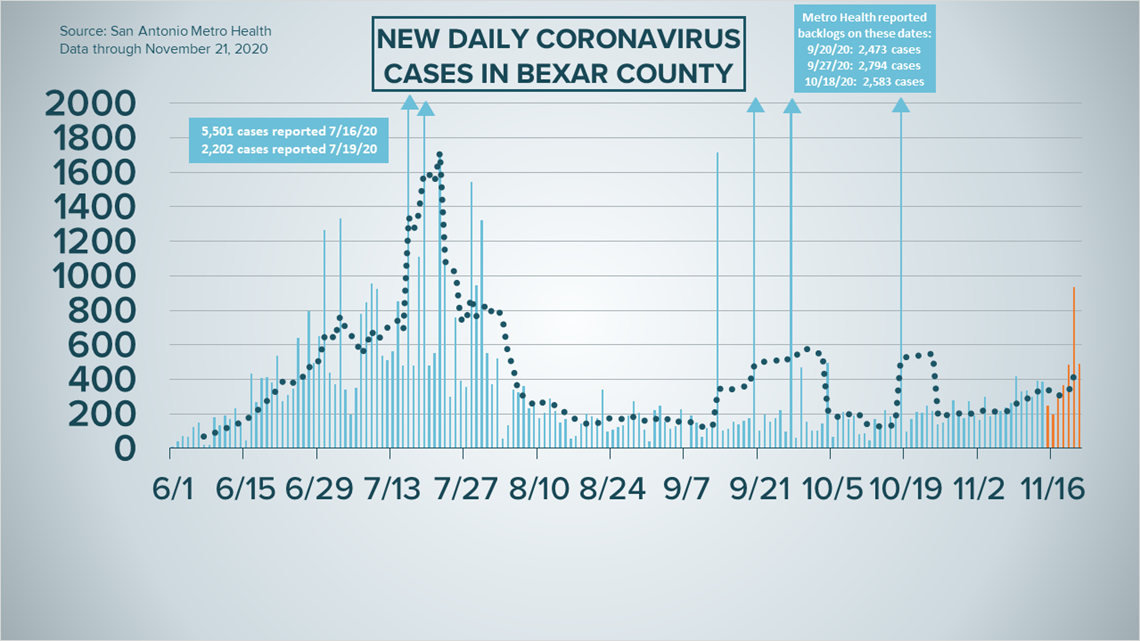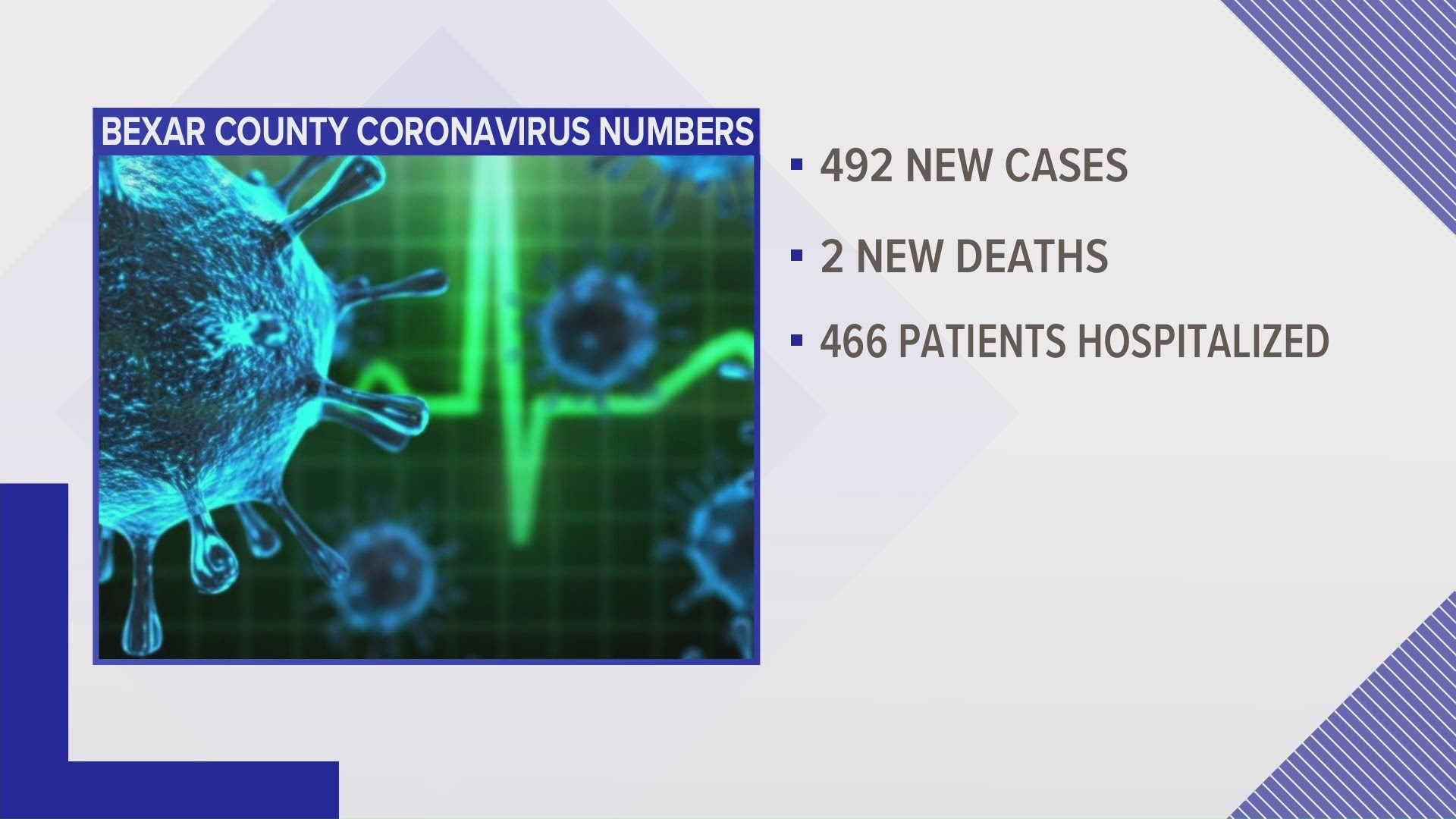SAN ANTONIO — We're tracking the latest numbers from the coronavirus pandemic in San Antonio and across Texas. Here are the latest numbers reported by Bexar and surrounding counties:
- Bexar County: 492 new cases were reported Saturday, bringing the total number of cases for the county to 72,805. Two new deaths were also reported, bringing the death toll to 1,318.
- Comal County: The county reported 50 new COVID-19 cases Friday and no new virus-related deaths. There have been a total of 4,338 reported cases of COVID-19 in the county – including 3,110 lab-confirmed cases – while 125 county residents have died. County officials say there are 398 active coronavirus cases, and 3,815 residents are considered recovered.
- Hays County: Officials in Hays County on Friday reported 71 new cases in the county and one additional COVID-related fatality. As of Friday, there are a total of 6,960 lab-confirmed cases in the county (671 of which are active), while the death toll rose to 96. 6,193 residents have recovered from the virus.
More county case information is available through the Texas Department of Health Services COVID-19 dashboard.
How Bexar County is trending
We've tracked how many coronavirus cases have been confirmed in Bexar County from the time officials began reporting cases in March 2020. The graphic below shows the number of cases since June and charts those daily case numbers along a 7-day moving average to provide a more accurate picture of the overall coronavirus case curve in our area and the direction we're trending amid the pandemic.
On Saturday, Metro Health updated its online coronavirus-tracking dashboards to reflect an additional 492 cases in Bexar County. Since the pandemic began, at least 72,805 county residents have been diagnosed with the virus. Meanwhile, 1,318 residents have died from coronavirus complications, following two more reported fatalities on Saturday.


After hospitalizations marginally increased by a few COVID-19 patients each day this week, the local figure shot up on Saturday to 466, which is 22 more patients than were hospitalized in area hospitals on Friday. OF those, 66 are on ventilators (no chance from Friday) while 148 are in intensive care (seven more from Friday).


Coronavirus in Texas
The total number of novel coronavirus cases in the state since the pandemic began grew by 13,763 on Friday, according to the Texas Department of State Health Services, including 12,597 new cases—a record tally for the Lone Star State. The rest are cases attributed to backlogs that were previously not included in the state's total. (More details can be found at the top of this page.)
As of Friday, 1.13 million Texans have contracted COVID-19.


State health authorities also reported 171 additional virus-related deaths on Saturday. At least 20,467 Texans have passed away from COVID-19 complications.
A day after COVID-19-related hospital admissions surpassed 8,000 for the first time in several weeks, the figure rose again on Saturday to 8,245; that's an increase of 81. The number of current Texas hospitalizations hasn't been that high since August 6, and it reflects a trend of increased virus spread that began at the start of October.
Since the start of October, the number of Texas hospitalizations has increased by 158%. Meanwhile, the state estimates that 909,137 Texans have recovered, while 158,383 Texans remain ill with COVID-19.
Meanwhile, the latest update from the Texas Education Agency showed that there have been 50,420 cumulative cases among staff and students across the state through Nov. 15. More information can be found here.
The TEA releases new data on school cases every Thursday.
Latest Coronavirus Headlines
- US passes 12 million COVID-19 cases, nearly 200,000 recorded on Friday
- Ben Carson says he was 'desperately ill' from COVID-19
- 'This is not fake news': Dr. Fauci talks holiday travel safety and upcoming vaccines in 1-on-1 interview
- Who will be eligible to get a coronavirus vaccine first, and when?
- VERIFY: You should wear a mask, recent Danish study doesn't prove otherwise
- El Paso County officials plead for more morgue workers as coronavirus fatalities climb
- Texas will track who gets a COVID-19 vaccine
- The U.S. military has been called to help Texas combat COVID-19 twice. Here’s where
- What does emergency use for a COVID-19 vaccine mean?
Coronavirus symptoms
The symptoms of coronavirus can be similar to the flu or a bad cold. Symptoms include fever or chills, cough, shortness of breath or difficulty breathing, fatigue, muscle or body aches, headache, new loss of taste or smell sore throat, congestion or runny nose, nausea or vomiting and diarrhea, according to the Centers for Disease Control.
Most healthy people will have mild symptoms. A study of more than 72,000 patients by the Centers for Disease Control in China showed 80 percent of the cases there were mild.
But infections can cause pneumonia, severe acute respiratory syndrome, kidney failure, and even death, according to the World Health Organization. Older people with underlying health conditions are most at risk.
But infections can cause pneumonia, severe acute respiratory syndrome, kidney failure, and even death, according to the World Health Organization. Older people with underlying health conditions are most at risk.
Experts determined there was consistent evidence these conditions increase a person's risk, regardless of age:
- Chronic kidney disease
- COPD (chronic obstructive pulmonary disease)
- Obesity (BMI of 30 or higher)
- Immunocompromised state (weakened immune system) from solid organ transplant
- Serious heart conditions, such as heart failure, coronary artery disease, or cardiomyopathies
- Sickle cell disease
- Type 2 diabetes
The CDC believes symptoms may appear anywhere from two to 14 days after being exposed.
Human coronaviruses are usually spread...
- Between people who are in close contact with one another (within about 6 feet).
- Through respiratory droplets produced when an infected person coughs, sneezes or talks. These droplets can land in the mouths or noses of people who are nearby or possibly be inhaled into the lungs.
- Some recent studies have suggested that COVID-19 may be spread by people who are not showing symptoms.
Help stop the spread of coronavirus
- Stay home when you are sick.
- Eat and sleep separately from your family members
- Use different utensils and dishes
- Cover your cough or sneeze with your arm, not your hand.
- If you use a tissue, throw it in the trash
Find a Testing Location
City officials recommend getting a COVID-19 test if you experience fever or chills, cough, shortness of breath or difficulty breathing, fatigue, muscle or body aches, headache, new loss of taste or smell, sore throat, congestion or runny nose, nausea or vomiting, or diarrhea.
San Antonio operates several no-cost testing locations, including two walk-up locations open Monday-Sunday from 10 a.m. until 2 p.m.:
Cuellar Community Center
5626 San Fernando St.
San Antonio, TX 78237
Ramirez Community Center
1011 Gillette Blvd.
San Antonio, TX 78224
Additionally, Freeman Coliseum offers drive-through no-cost testing from Monday through Sunday between 9 a.m. and 4 p.m. An appointment is required and can be made either online or by calling (833) 213-0643.
Here's a Testing Sites Locator to help you find the testing location closest to you in San Antonio.

